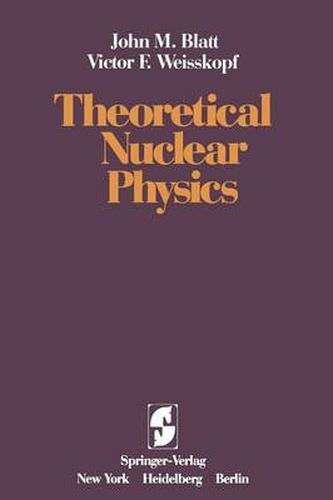Readings Newsletter
Become a Readings Member to make your shopping experience even easier.
Sign in or sign up for free!
You’re not far away from qualifying for FREE standard shipping within Australia
You’ve qualified for FREE standard shipping within Australia
The cart is loading…






This title is printed to order. This book may have been self-published. If so, we cannot guarantee the quality of the content. In the main most books will have gone through the editing process however some may not. We therefore suggest that you be aware of this before ordering this book. If in doubt check either the author or publisher’s details as we are unable to accept any returns unless they are faulty. Please contact us if you have any questions.
The last twenty years have witnessed an enormous development of nuclear physics. A large number of data have accumulated and many experimental facts are known. As the experimental techniques have achieved greater and greater perfection, the theoretical analysis and interpretation of these data have become correspondingly more accurate and detailed. The development of nuclear physics has depended on the development of physics as a whole. While there were interesting speculations about nuclear constitution as early as 1922, it was impossible to make any quantitative theory of even the simplest nucleus until the discovery of quantum mechanics on the one hand, and the development of experimental methods sufficiently sensitive to detect the presence of a neutral particle (the neutron) on the other hand. The further development of our understanding of the nucleus has depended, and still depends, on the development of ever more powerful experimental techniques for measuring nuclear properties and more powerful theoretical techniques for correlating these properties. Practically every simple,
reasonable, and plausible assumption made in theoretical nuclear physics has turned out to be in need of refinement; and the numerous attempts to derive nuclear forces and the properties of nuclei from a more fundamental approach than the analysis of the data have proved unsuccessful so far. Nuclear physics is by no means a finished edifice.
$9.00 standard shipping within Australia
FREE standard shipping within Australia for orders over $100.00
Express & International shipping calculated at checkout
This title is printed to order. This book may have been self-published. If so, we cannot guarantee the quality of the content. In the main most books will have gone through the editing process however some may not. We therefore suggest that you be aware of this before ordering this book. If in doubt check either the author or publisher’s details as we are unable to accept any returns unless they are faulty. Please contact us if you have any questions.
The last twenty years have witnessed an enormous development of nuclear physics. A large number of data have accumulated and many experimental facts are known. As the experimental techniques have achieved greater and greater perfection, the theoretical analysis and interpretation of these data have become correspondingly more accurate and detailed. The development of nuclear physics has depended on the development of physics as a whole. While there were interesting speculations about nuclear constitution as early as 1922, it was impossible to make any quantitative theory of even the simplest nucleus until the discovery of quantum mechanics on the one hand, and the development of experimental methods sufficiently sensitive to detect the presence of a neutral particle (the neutron) on the other hand. The further development of our understanding of the nucleus has depended, and still depends, on the development of ever more powerful experimental techniques for measuring nuclear properties and more powerful theoretical techniques for correlating these properties. Practically every simple,
reasonable, and plausible assumption made in theoretical nuclear physics has turned out to be in need of refinement; and the numerous attempts to derive nuclear forces and the properties of nuclei from a more fundamental approach than the analysis of the data have proved unsuccessful so far. Nuclear physics is by no means a finished edifice.